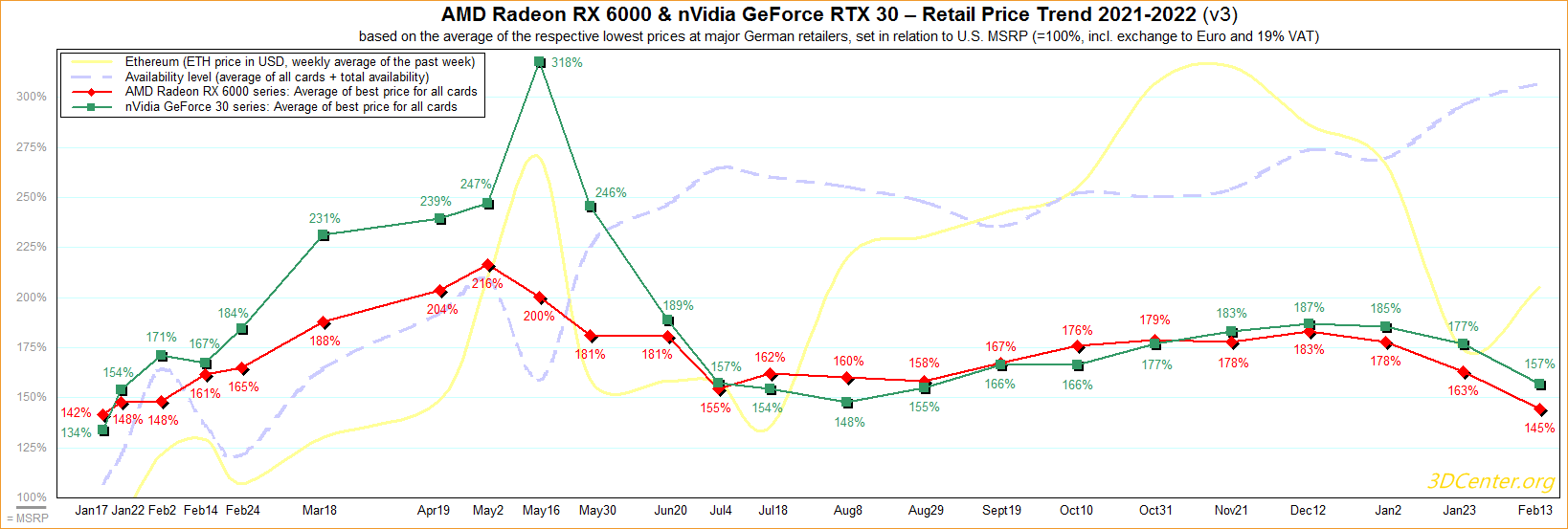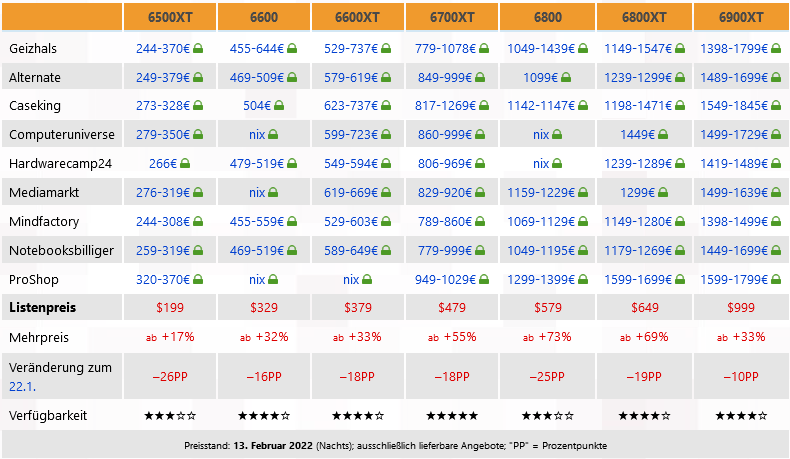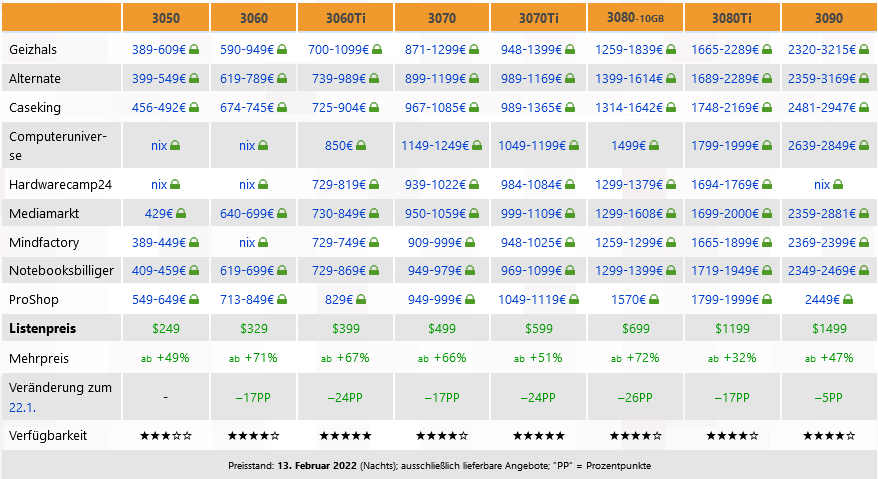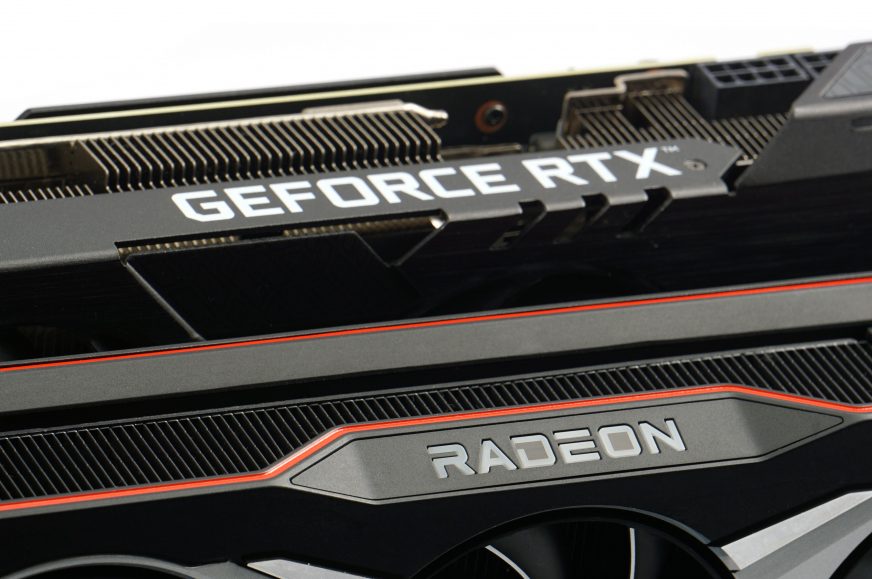A hope of getting normal graphic card prices, finally?
Although the chip shortage crisis is far from ending with new and potentially dangerous problems arising in the world, some semblance of normality might now be coming to hardware prices. Of those, graphic cards are the most affected by the crisis and also most important to us. The last couple of weeks have seen a promise of the end of the current state of desolation with epic prices and “soviet-style” empty shelves.
This change might not be visible in smaller markets yet. 3DCenter.org web has been monitoring the development of graphic card prices on the German market, the trends of which do bear a certain global relevance that should more or less translate to the market as a whole. It have been precisely this web’s statistics that we were informing you about at the start of July of the previous year, when things seemed to have been taking a turn for better, briefly. But then the crypto traders caught a second breath and the Bitcoin, Ethereum and co. bubble has again gained some momentum, increasing GPU prices.
However current statistics imply that this price bounce is already behind us. The price increases have peaked in the end of December and since then the prices are slowly getting lower (and even the price inflation that has happened during the summer has been eliminated since). 3DCenter takes averages of various graphic card models offered by big German sellers, using them to calculate a surcharge percentage you spend on GPUs when compared to the recommended price – e.g. 100 % means prices match the MSRPs while 200 % means double prices.
Cheapest graphic cards since 2021
As you can see in this graph the biggest disaster has taken place in May of the last year, when Radeon prices have climbed to more than double the recommended price and GeForce even surpassed a triple (likely due to the miners’ panic before the arrival of LHR cards with reduced mining performance). At the start of July, the surcharge was around 55 to 57 % on average, however by December it had climbed back to 87 % with GeForce and 83 % with Radeon cards.
The numbers for January and February display a quick reversal – the two weeks leading up to the 13th of February show that GeForce prices have again reached only a 57 % surcharge on average, when compared to the recommended price. This is not so great yet, since Nvidia graphic cards had briefly been even cheaper in August (with a 48 % surcharge). However Radeon prices have dropped even lower and at the point of the last data compilation, there was only a 45 % surcharge on average. This is the best result since January 2021 (at which time the surcharge was at 42 %).

3DCenter also reports that the stock availability (for 2021 and 2022) as marked by the blue-violet dashed line in the graph has been the best yet in the most recent weeks.
It has to be added however, that this process might slow down again, since crypto currencies have recovered some of their strength after having taken a beating in the end of January. It also has to be remarked that 3DCenter statistics do not operate with all graphic card prices, but instead take into account just the lowest prices a certain model can be bought at at a particular store. So if you would take a look at a random graphic card model in random etailer’s catalogue, you would likely find a noticeably higher price. Therefore these optimistic numbers should be taken with a grain of salt. We just have to hope that this positive trend will continue and reach a surcharge below 20 %, ideally 10 %. Because let’s be honest: a “mere 50 %” surcharge in graphic card prices is simply a lot of money. The recommended prices of GPUs are themselves already quite high, after all. Of course, we also have to hope that such trends in the German market will eventually translate themselves into other regions as well.
Lowend AMD cards see bigger price fall than Nvidia’s
The 3DCenter report features tables with card prices that have been used for the calculations, so you can compare these yourself. The surcharge (marked as „Mehrpreis“) is listed for individual Nvidia and AMD models, so the situations for expensive, mainstream and “cheap” graphic cards can be compared.

This comparison suggests that AMD is currently successful (at least in Germany) at getting their cheaper cards to cheaper prices – Radeon RX 6600 and RX 6600 XT are overpriced only by 32 % and 33 % respectively and it is especially interesting that the price of the recently released Radeon RX 6500 XT is overcharged only by 17 %. It is however also true, that these models have been released with relatively high recommended prices to begin with, therefore it might be argued that an implicit surcharge is present even at “0%” (this generally applies to the majority of the current GPU generation of both companies).

The cheapest Nvidia card, the GeForce RTX 3050, is presently at +49% price, but it has been released just recently, so there is some hope left that the situation could improve (for example thanks to the introduction of cards using the GA107 die). GeForce RTX 3060 and RTX 3060 Ti have a surcharge of 71 % and 67 %. The best rate in Nvidia’s offering is achieved by the GeForce RTX 3080 Ti (with a price that is just 32 % higher than recommended), however this is also likely due to the high starting price (1199 $) set by Nvidia. A similar exception is the Radeon RX 6900 XT, which was introduced at a lower but still quite high starting price of 999 $ and that is very likely exactly the reason why it has a surcharge of only 33 %.
Sources: VideoCardz, 3DCenter
English translation and edit by Karol Démuth, original text by Jan Olšan, editor for Cnews.cz
⠀











